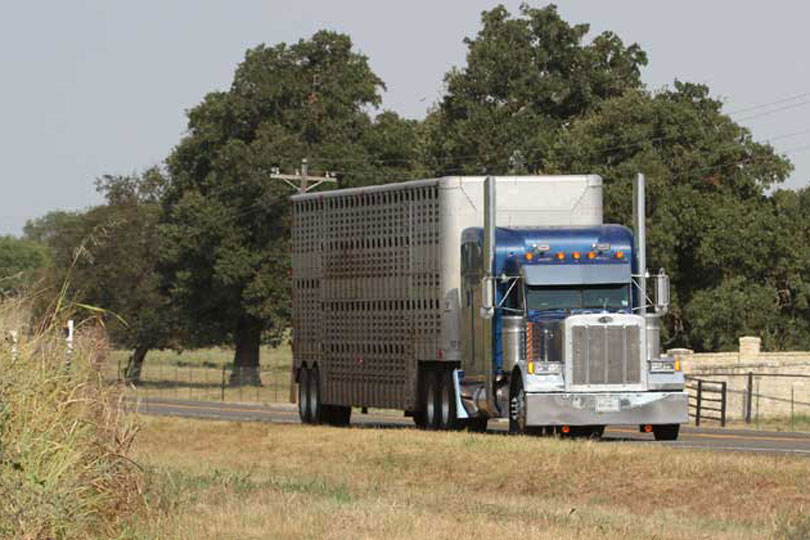Organizations representing livestock, bee and fish haulers across the country submitted a petition to the Department of Transportation (DOT) requesting additional flexibility on hours of service (HOS) requirements.
The petition asks for a five-year exemption from certain HOS requirements for livestock haulers and encourages DOT to work with the livestock industry to implement additional fatigue-management practices.
Current rules limit drive time to 11 hours and limit on-duty hours to 14.
Instead, the organizations request that livestock haulers be granted approval to drive up to 15 hours with a 16-hour on-duty period, following a 10-hour consecutive rest period. Any livestock hauler wishing to operate under the extended drive time would be required to complete pre-trip planning and increased fatigue-management training.
“We are concerned that the 11- and 14-hour rules were not drafted with livestock haulers in mind, and thus do not accommodate the unique character of their loads and nature of their trips,” the organizations wrote. The current requirements “place the well-being of livestock at risk during transport and impose significant burdens on livestock haulers, particularly in rural communities across the country.”
The strong safety record of livestock haulers demonstrates their ability to ensure the well-being of both live animals and other drivers on the road. A 2014 analysis by the Federal Motor Carrier Safety Administration found that livestock haulers were underrepresented in truck-involved fatal crashes. Data cited in the petition also shows that, between 2013 and 2015, livestock haulers accounted for 6.6 percent of all commercial drivers but less than one percent of crashes involving large trucks.
Australia already implements rules for livestock haulers that focus on safety outcomes, not prescriptive limits. The petition encourages DOT to work with industry to develop and implement similar measures.
“When livestock and other live animals are transported, it’s important to get them to their destination safely and without delay or disruption. Safety for the driver and others on the road is a priority,” Zippy Duvall, American Farm Bureau Federation president, said. “That is why we are petitioning DOT to adopt modern fatigue-management practices that provide the same or greater level of safety while avoiding unintended and unnecessary stress on the animals entrusted to our care.”
The petition was signed by AFBF, National Cattlemen’s Beef Association, Livestock Marketing Association, American Farm Bureau Federation, American Beekeeping Federation, American Honey Producers Association and the National Aquaculture Association.


This should not be a 5 year exception but a permanent exemption. Horses for example require special people and equipment to haul them successfully. Drivers have to be horsemen and women, veterinarians to an extent, horse trainers, experts in equine animal husbandry, mechanics and trip planners. Enroute to a show we cannot slide off to a rest area to sit for 11 or 12 hours rest with a load of horses. That is not possible because there are few horse hotels around not to mention the expense with as many as 6 to 8 or more horses in multiple trailers.. The only one I know of is in Minot North Dakota. A jumping off point going into Canada.
These are all small business people who have been slapped recently with an economic depression not of their doing that hurt the Equine industry. It also has been stuck with maniacal federal regulation that turned diesel into an expensive boutique fuel that has increased the cost of both feed and fuel as ethanol continues as a mandate we all pay for that decreases fuel mileage. At a time when the government asked us to conserve the government gave us worse fuel mileage and are forced to pay for it as well. Now we have another dependent society—-the corn farmer that we pay to keep prices high in feed, fuel and food. We lose to this federal farmer patronizing campaign. If ethanol is so great allow the ethanol industry to compete with gasoline.
There are also 4H Clubs hauling cattle, sheep, chickens, hogs, and what not to county fairs across the Nation. These are the future of our agriculture industry but since the fairground isn’t in the middle to Times Square or the Washington Mall these moms and dads and kids carry on the family tradition of producing the best agricultural products in the world as unseen gems that produce great products to this country.
Talking about the revenue side this is a tiny industry compared to commercial trucking, these people are required by economics to charge for transport of horses and livestock to shows around this country and Canada. With the non market driven price of fuel that is still being set by the Royal Saudi Family OPEC Cartel USA based oil companies are happy to accept their oil prices as we export crude ripping off the American citizen in my view.
Forcing moms, dads and trainers to get commercial licenses for their 1 ton diesel dually they use to pull a 36 foot Featherlight to maybe a dozen shows a year is an added unnecessary burden to be realistic. It is unfortunate there are a few horsemen out there with the money and resources to buy a Freightliner tractor to pull his trailer but most of us do not. I think as the big 3 Ford, Chevy and Dodge continue to advance their products to handle more and more weight I think the weight restrictions should be increased to 40,000 lbs for ag licensed equipment. I think that might better suit the industry reflecting the improved truck and trailer technology and dedication to to continued excellent safety record in this small agriculture segment.
Ed Sunderland
1044 Colony St.
FLower Mound, TX 75028